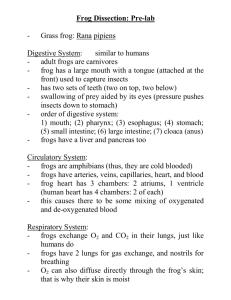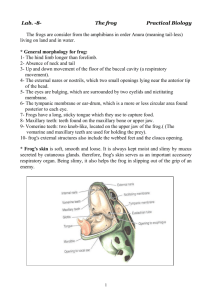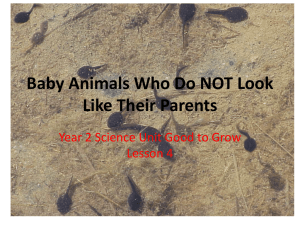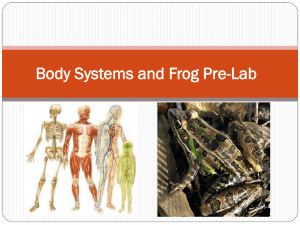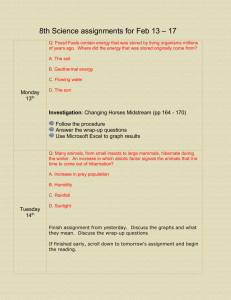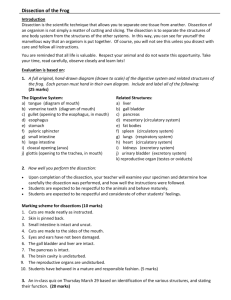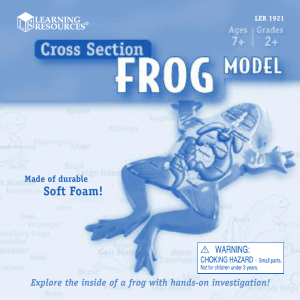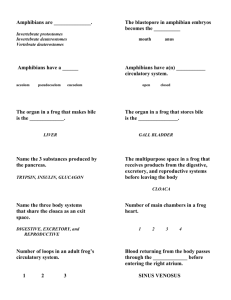Fetal Pig Dissection - South Florida Science Center and Aquarium
advertisement
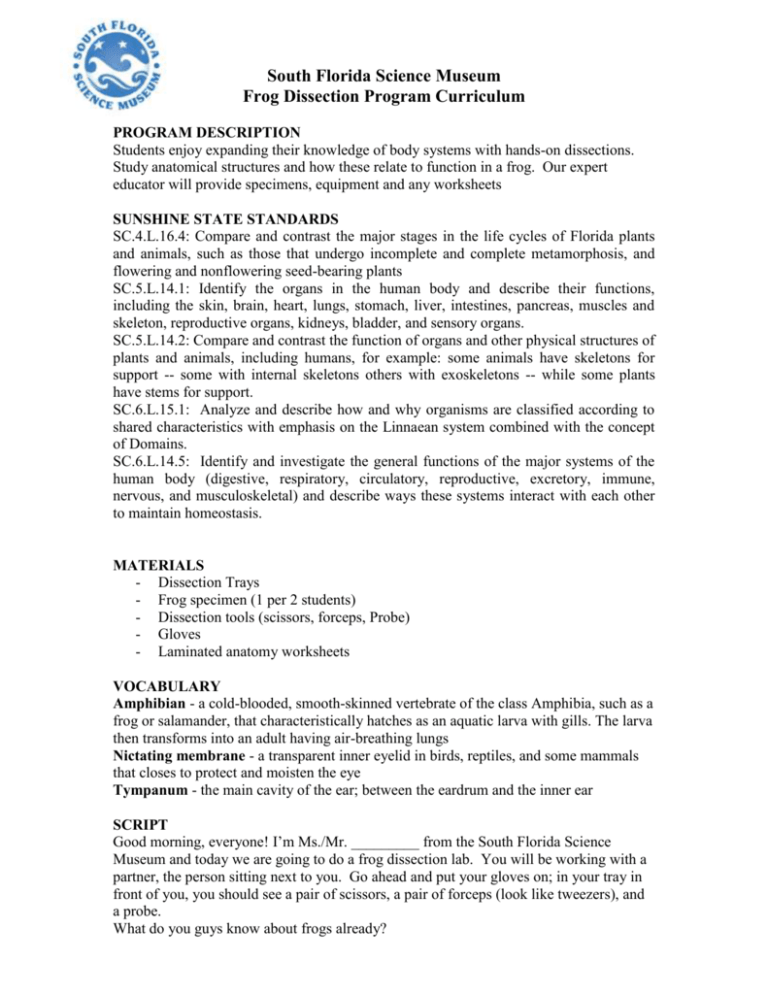
South Florida Science Museum Frog Dissection Program Curriculum PROGRAM DESCRIPTION Students enjoy expanding their knowledge of body systems with hands-on dissections. Study anatomical structures and how these relate to function in a frog. Our expert educator will provide specimens, equipment and any worksheets SUNSHINE STATE STANDARDS SC.4.L.16.4: Compare and contrast the major stages in the life cycles of Florida plants and animals, such as those that undergo incomplete and complete metamorphosis, and flowering and nonflowering seed-bearing plants SC.5.L.14.1: Identify the organs in the human body and describe their functions, including the skin, brain, heart, lungs, stomach, liver, intestines, pancreas, muscles and skeleton, reproductive organs, kidneys, bladder, and sensory organs. SC.5.L.14.2: Compare and contrast the function of organs and other physical structures of plants and animals, including humans, for example: some animals have skeletons for support -- some with internal skeletons others with exoskeletons -- while some plants have stems for support. SC.6.L.15.1: Analyze and describe how and why organisms are classified according to shared characteristics with emphasis on the Linnaean system combined with the concept of Domains. SC.6.L.14.5: Identify and investigate the general functions of the major systems of the human body (digestive, respiratory, circulatory, reproductive, excretory, immune, nervous, and musculoskeletal) and describe ways these systems interact with each other to maintain homeostasis. MATERIALS - Dissection Trays - Frog specimen (1 per 2 students) - Dissection tools (scissors, forceps, Probe) - Gloves - Laminated anatomy worksheets VOCABULARY Amphibian - a cold-blooded, smooth-skinned vertebrate of the class Amphibia, such as a frog or salamander, that characteristically hatches as an aquatic larva with gills. The larva then transforms into an adult having air-breathing lungs Nictating membrane - a transparent inner eyelid in birds, reptiles, and some mammals that closes to protect and moisten the eye Tympanum - the main cavity of the ear; between the eardrum and the inner ear SCRIPT Good morning, everyone! I’m Ms./Mr. _________ from the South Florida Science Museum and today we are going to do a frog dissection lab. You will be working with a partner, the person sitting next to you. Go ahead and put your gloves on; in your tray in front of you, you should see a pair of scissors, a pair of forceps (look like tweezers), and a probe. What do you guys know about frogs already? 1) These frogs are grass frogs *we order the biggest grass frogs you can get 2) The biggest kind of frog = called Goliath frogs a. Live in West Africa b. About 1 foot long and weighs about the same as a large house cat 3) The smallest kind of frog = Gold frog a. 1 cm long 4) Does anybody know the name of the most poisonous frogs? *Poison arrow or Poison dart frogs *Why do you think they have poison on their skin? -protection 5) What group of animals do frogs belong to? a. AMPHIBIANS 6) What are traits of amphibians? a. Cold blooded b. Lay eggs c. Moist, smooth skin d. Born in water, but can live on land 7) What other animals belong to this group? a. Newts b. Salamanders c. Toads 8) What’s the difference between frogs and toads? a. F: smooth, moist skin, T: rough, dry skin b. F: have long legs for jumping, T: have short legs for hopping c. F: have small teeth, T: don’t have any teeth d. F: have to stay near the water to keep their skin moist, T: can venture further from the water 9) Don’t get them confused with REPTILES a. Snakes b. Lizards c. Alligators/crocodiles d. Turtles *LOOK AT WORKSHEET* ~ There’s a way to tell if you have a boy or a girl w/o cutting it open **FLIP OVER FROG SO BELLY SIDE IS FACING UP** *Try to distinguish males and females by the large thumb pad being on the males *Also, the females are A LOT bigger? WHY? o To carry eggs o Some may have eggs inside of them ***FLIP BACK OVER (External)*** 1) Mouth a. Are they going to have big teeth? i. No, why not? - They don’t eat big things - what do they eat? insects & little fishes ii. Depending on how big they are, depends on what they eat - Ex: some big frogs can eat small rodents 2) Nose a. So does this mean they can smell? YES 3) Eyes a. Membrane = acts like an eyelid i. 2 eyelids: normal one (like ours) and a nictating membrane ii. protects, covers, and keeps excess moisture out (like a goggle) iii. also helps protects their eyes from sharp edges of the insects they eat 4) Tympanum a. Similar to our ear drums (vibrate according to sound) b. Located behind their eyes c. Have excellent hearing (primary sense organ) LENS DISSECTION *Draw diagram *Cut up, then across *Use probe or forceps to pull it out *2 eyeballs => 2 lenses => 2 people => both people can get a chance *Lens is a small yellowish ball *Draw diagram of ours vs theirs *Why the difference in shape? -Fishes and amphibians see through water -We see through air -When you open your eyes underwater, you can’t see as clearly, can you? ~ Because our eyes were not made to be able to see underwater *Flip Frogs Over (belly side up)* Make sure worksheet is on INTERNAL Draw diagram of cuts *2 cuts: ~cut skin ~cut muscle *Wait for my instruction *tip of scissors JUST going through top layer (don’t puncture organs) *watch for splatter *watch your fingers! *It will get harder to cut up by the mouth because you’re cutting through its chest cavity Once you have the skin AND the muscle open, wait for everyone else to get to that point *Can cut skin/muscle completely off if that helps *We’re going step by step, finding one organ at a time so stay with me 1) Liver a. Big brownish/greenish thing you see right away b. Looks like a mushroom c. Functions: flushes out toxins, produces red blood cells & produces bile to break down food d. Liver is very large = means the frog lives in a very dirty environment (mud) 2) Gall bladder a. Right behind the liver b. Looks like a deflated balloon, size of a pea c. Function: store bile ~*~*~*~REMOVE THE LIVER~*~*~*~ 1) We’re removing the liver since it’s covering a lot of the other organs 2) Lift it up 3) Snip at the top 4) Work with your partner ~ one holds it, one cuts it 5) Liver has right, left, and central lobe ~*REMOVE GALL BLADDER IF YOU CAN FIND IT~* 3) Digestive Tract a. Stomach => Small intestine => Large intestine => out b. Functions: i. Stomach-grinds up and breaks down food 1. hard tube along frog’s left side of organs ii. Small intestine – circulates digested food through the blood 1. thin tubing connected to the stomach iii. Large intestine – prepares leftover food for excretion 1. thicker tubing connected to the small intestine ~*~REMOVE WHOLE THING IN 1 PIECE IF YOU CAN~*~* >cut the top of the stomach 4) Fat bodies a. = yellow stringy things b. Help store energy and moisture 5) Kidneys a. = little brown patches on either side of the back of the frog (behind everything else) b. Function: separate water from the toxins 6) Spleen a. = brown bean nestled in the center of the intestines b. Function: creates white blood cells (immune system), fight bacteria and viruses 7) Heart a. Way up by the head (almost by the throat) b. If you only cut up to the arms, you didn’t cut high enough c. How many chambers does an amphibian heart have? i. 3 8) Lungs a. On either side of the heart b. Look like raisins c. Expand to hold more oxygen when they go in the water d. So if they have lungs, what do they breathe? i. Air e. Do they always breathe through their lungs? i. No, when they’re tadpoles, they breathe through their gills ii. Can also breathe through their skin (used when underwater) If you have a pregnant one ~ eggs will have brown and white speckles No eggs? Most likely have a male CLEAN UP INTERNAL AND EXTERNAL DIAGRAM WORKSHEETS

